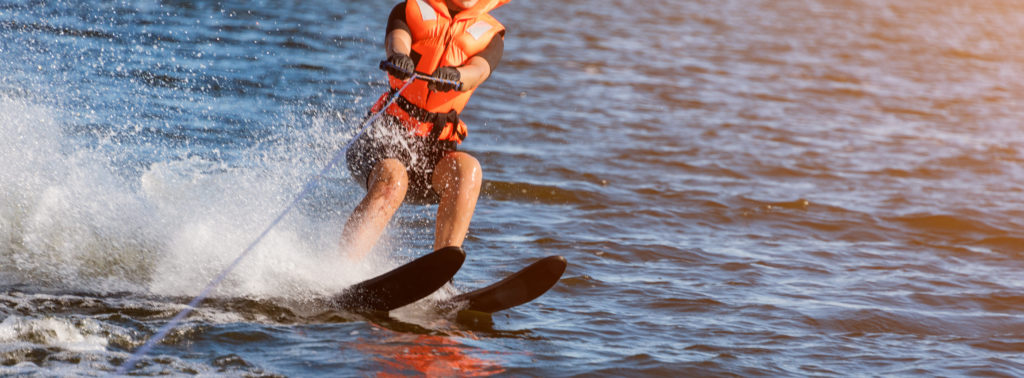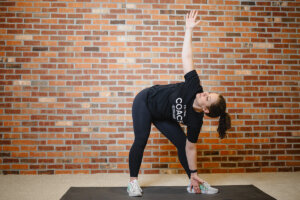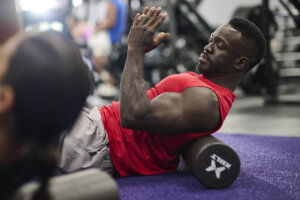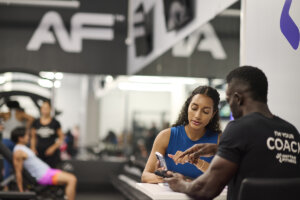In the spirit of outdoor activity and putting the fun in fitness, here’s some great information and exercises that will improve your water-skiing. Prefer the colder cousin to water skiing, downhill snow skiing? No problem! This article focuses on strengthening your skiing skills, and while we created it with water in mind, the tips are definitely applicable for improving your downhill technique on land. Heck, if surfing is one of your interests, they’ll even help with that too!
Water skiing was created by Ralph Samuelson, on Lake Pepin in Lake City, Minnesota, about 100 years ago in June of 1922. If you’re wondering what water skiing equipment was like back then, Samuelson used sash cord material as the water ski rope, an iron ring covered with tape at the end of the rope for a ski handle, and two boards from the lumberyard for his pair of skis. His brother was the driver of the boat, and Samuelson was able to stay up for a few yards on his first trip, despite being the world’s first novice skier. We think that’s a pretty great story!
The right equipment for the sport has certainly changed since Samuelson’s wooden board days — for one thing, a PFD such as a life jacket is absolutely required. But as anyone who has tried it knows, water-skiing is more complicated than standing up and holding onto a rope! It’s a sport of skill and strength, and requires many muscle movements to do it right and comfortably. You’re essentially working your body from your ankles in the ski bindings and boots to your thumbs! When getting ready to hit the water, focus on developing these key areas while in the gym (we don’t want unauthorized splits with those skis on!): leg stability, inner thighs, back, core and forearms.
With a little extra attention, you’ll find you’re able to get out of the water easier, feel more stable cutting in and out of the boat wake, up your speed by a few miles per hour and prolong that beautiful ride by minutes, not seconds. Don’t think you’re a water skier? If that’s the case, maybe this article will convince you otherwise!
Water Skiing Tips
If you’re not a water skier, know that it’s a great, challenging workout that’s worth a try. Water sports like water-skiing and wakeboarding are a great way to get out in nature on a beautiful day, and some of the best workouts you can do on the lake! Besides, when else do you get to travel right on the surface of the water at a pace of 15 miles per hour?
The first thing to know when you start out as a water skier is that you can either do a dock start or a deep-water start. For a dock start, you start at the end of the dock holding the ski rope, and get pulled by the driver from there. A deep-water start is exactly what it sounds like: for a deep-water start, the boat driver will bring the boat to the center of the lake, then help you get set up in the water with the ski rope. For first time skier students, it’s usually a good idea to start from the dock, as it can be difficult to get skis on your feet in open water! Another recommendation for first time students is to use trainer skis. One of the harder parts about skiing is keeping both skis up and in a straight line against the forces of the water and ski boat driver. Trainer skis have a small piece of rope or plastic at the tip of the skis that keep them together. This takes pressure off the skier, who already has a lot to think about when they’re focused on getting up! Trainer skis are popular for kids, so it can be harder to find them for adult skis, but there’s no shame in using them to start, regardless of your age or years of experience. There are also EZ ski trainers, which are inflatables that mimic skis, for children.
As any ski instructor will tell their students, getting up is the hardest part of water skiing, and there are a lot of important things to remember in the moment. Remember that practice makes perfect, and most people will fall a bit before they get it right! Learning to ski can feel like a vicious cycle of falls, but when you have energy and muscle strength on your side, you’ll pop up in no time! Make sure you dig your heels in, point the skis straight forward (trainer skis help with this), keep your elbows in, knees bent and and your hands tight on the rope handle. You’ll want to keep your head and eyes facing forward and looking up, and let your body handle the rest. It’s important to make sure your feet are tight in the bindings – your toes should be cushioned in. There’s definitely a little personalization in this movement, but the basics for each person are the same. Video guides can be helpful, too. If you’re struggling, make sure the ski boat driver is starting with enough speed on the boat pull to get you on top of the water, and keep you there. If engine speed isn’t the problem, another option is to try using a ski tow bar device, which helps keep the ski handle and rope out of the water. (It works well for tubes, too, similar to a shock ball!)
And of course, it’s absolutely crucial that you wear a life vest or jacket, no matter how talented of a skier you are. Make sure that your friends and family, or whoever is spotting you from the back of the boat, are familiar with safety hand signals like thumbs-up and thumbs-down so that you can communicate with them if you need to stop. That job is known as being the spotter, and it’s an important one!
One lesson to keep in mind is that being a pro or new water skier is as much in your head and mind as it is in your muscles. It doesn’t matter how much you work out on solid ground: It’s not easy to be pulled on a handle, behind a boat, in any direction the driver chooses, wearing no gear except a life jacket, at a speed of 15-20 MPH. For most people, kids or adults, it’s not exactly a natural thing! That’s where your mindset comes in. Skiing can deplete your energy in just the first attempt, but if you’re in the right mindset and thinking about how much fun you’re having, you can take your ski run from seconds to minutes, and get a great workout in. Just make sure that if you feel major pain outside of muscle exertion at any point, you stop. You don’t want to wake up with stiff joints and an injury the next morning!
Types of Skis
Let’s go over some important information about the different types of skis. In addition to trainer skis, there are combo skis, slalom skis and trick skis. Trick skis are, as the name implies, designed for performing tricks on the water. Their shape is wider and shorter than regular skis, to provide stability. For trick skiers, skiing is as much a fun game as it is a hobby. There are even worldwide water sports competitions and events for it! Trick skiing is some of the fastest skiing out there, and the best skiers in the world are moving at over 20 MPH, performing incredible new tricks like looping in the air at maximum speed. Of course, trick skiing increases your risk of injury, so it’s best not to try it until you’ve mastered being a student of regular and slalom skiing. Slalom water skiing is just like regular skiing, except with only one single ski! The single slalom skis have adjustable binding for both your feet. You’ll be pulled at faster MPH, and you’ll need a really strong core to keep your balance. It may sound intimidating, but it’s a great challenge, and if you’ve mastered regular water skiing’s learning curve after a few weeks, you might want to give slalom-style a try! If you’re wondering which foot to put in front, most left-handed people start with their right foot in front (so that their dominant foot is in the back), and vice versa.
Having the flexibility to choose between double or slalom skiing is the reason that many people buy combo skis. Combo skis have binding for two feet on one ski, and binding for one foot on the other ski, so they can be used by regular and slalom skiers alike.
Water Skiing Strength
The sport of water skiing requires maximum output from the muscles throughout your entire body, so water skiers will want to focus on training their core muscles, lower body and upper body strength. In addition to a strong core and body, you also want to think about grip strength and endurance. Unlike most workouts, like cardio or powerlifting, waterskiing requires you to hold the same slightly-sitting position. Of course, you’ll shift your stance slightly if you encounter waves, or if your driver makes a sudden turn, but your stabilizer muscles and abs will mostly just be holding you in place. That’s why strong legs, strong core muscles and a strong upper body are all so important for keeping that stance!
Here are some basic, functional categories of exercises that you can try today to help you take the next step of strengthening all of those areas and get your muscles and joints ready to rock the slopes—the water ski slopes of course! We recommend cycling through these exercises in whatever order you like, with 8-12 repetitions of each exercise and 2-3 visits to the gym per week, to gain a serious advantage on a pair of skis, whether you’re a beginner or have years of experience. Not only will they improve your skill level, but you’ll also be stronger at all the small activities that go along with skiing, like getting the skis on in the water or handing them up to your spotter at the side of the boat.
Inner Thighs
Your legs will bear your weight, with your knees bent slightly, as you stand upright on the water. Strengthening them plays an important role in making your ride longer and far more enjoyable!
Lateral Lunges: Make sure to keep one leg straight and focus on sitting back on your hip as you step to each side. Weights are not necessary, but adding small (5-10 lbs) or large (15-20 lbs) weights – whatever size works for you – is a great way to increase intensity and momentum, plus burn extra calories. You can always start with body weight and add weights next time.
Back
Your back and your core work together to keep you stabilized while you ski. While they won’t necessarily be in motion, they’re the key to success in staying up, especially when you’re trying to take in all the scenery on the edge of the shore!
Single Arm Standing Rows: This exercise is a great way to build strength and stability at the same time. Use whatever size weights you’re comfortable with, and make sure you keep your elbow at a 90-degree angle when you drive the dumbbells back!
Core
Simple crunches just won’t put enough pressure on your abs to give you the core strength you need for a sport — that’s a fact. Focus on the kind of movements that push your core to the edge while standing on the ground. These are also a good way to burn more calories because you’re engaging your total body, not just your abs. We also recommend pull-ups, if that’s in your fitness wheelhouse!
Anti-Rotation Overhead Press: You’ll need a pulley machine and cable rope attachment for this one. Set the weight to something in the low to medium range, between 10 pounds and 20 pounds. Start with the band pressed into your chest and push up above your shoulders with control, while keeping your core engaged. Make sure to keep a straight vertical line throughout the action of pushing up. Raise the attachment until your arms are straight, but stop a few inches before you lock your elbows. Repeat!
Side Planks with a Row: This movement is another great core strength exercise. You’ll start in a side plank, with a lighter weight (5 lb to 10 lb) in the hand that’s off the ground. Pull the weight up using a row motion, touch it back to the ground, and repeat.
Forearms
While working all of these muscles, it’s easy to forget the simple things that apply to water-skiing, like holding on!
Dumbbell Farmer’s Walks: Hold heavy dumbbells or kettlebells by your side, keep your back straight, and WALK! Done deal. We recommend starting with 10 lb weights and adding weight accordingly.
Remember, like any surface water sport, water skiing is challenging, for expert and beginner water-skiers alike! However, it’s also an amazing opportunity to experience a body of water like never before, and to push yourself to the edge in terms of trying something new. Make sure you have the right length of rope, an equipped water ski boat with a solid engine and propeller (some boats, like pontoons, don’t have a strong enough engine to hit the boat speed required for skiing), a boater who knows the rules of the lake, a person to be your spotter and of course, a proper life jacket (not just a PFD). We hope that this workout helps you build excitement and confidence for taking your first step into skiing season!



